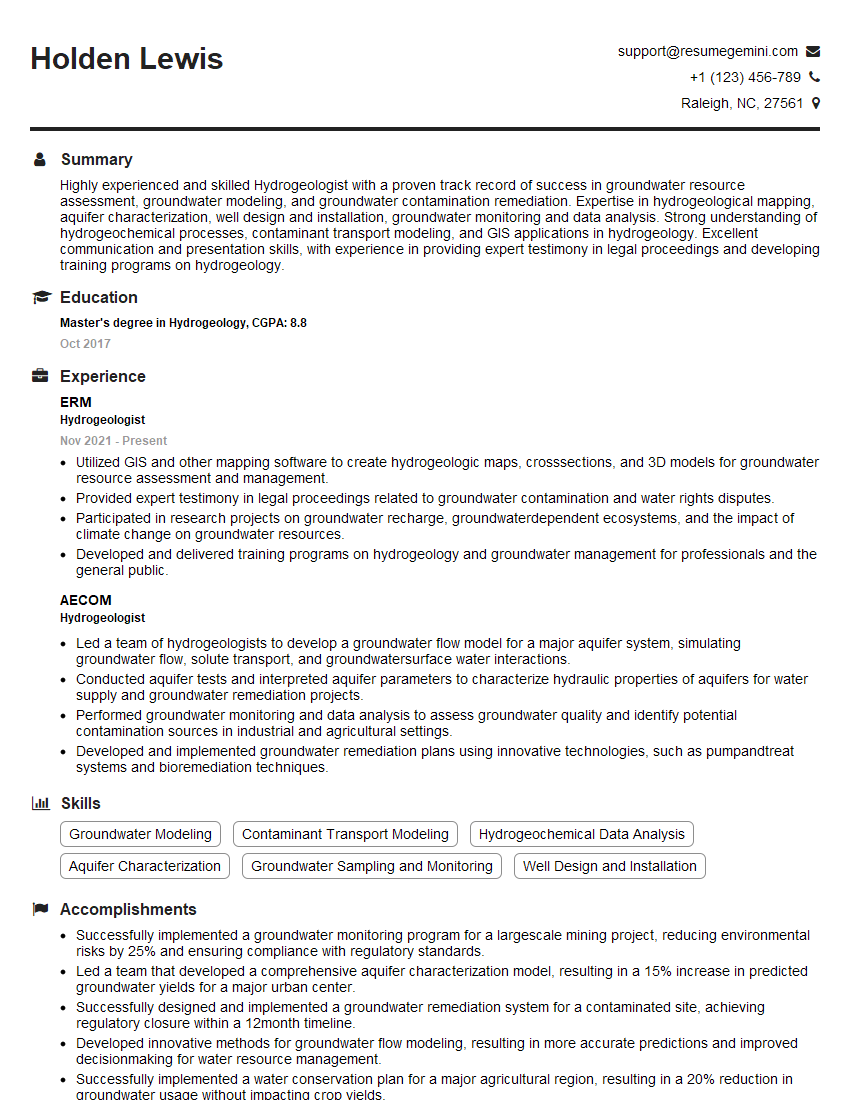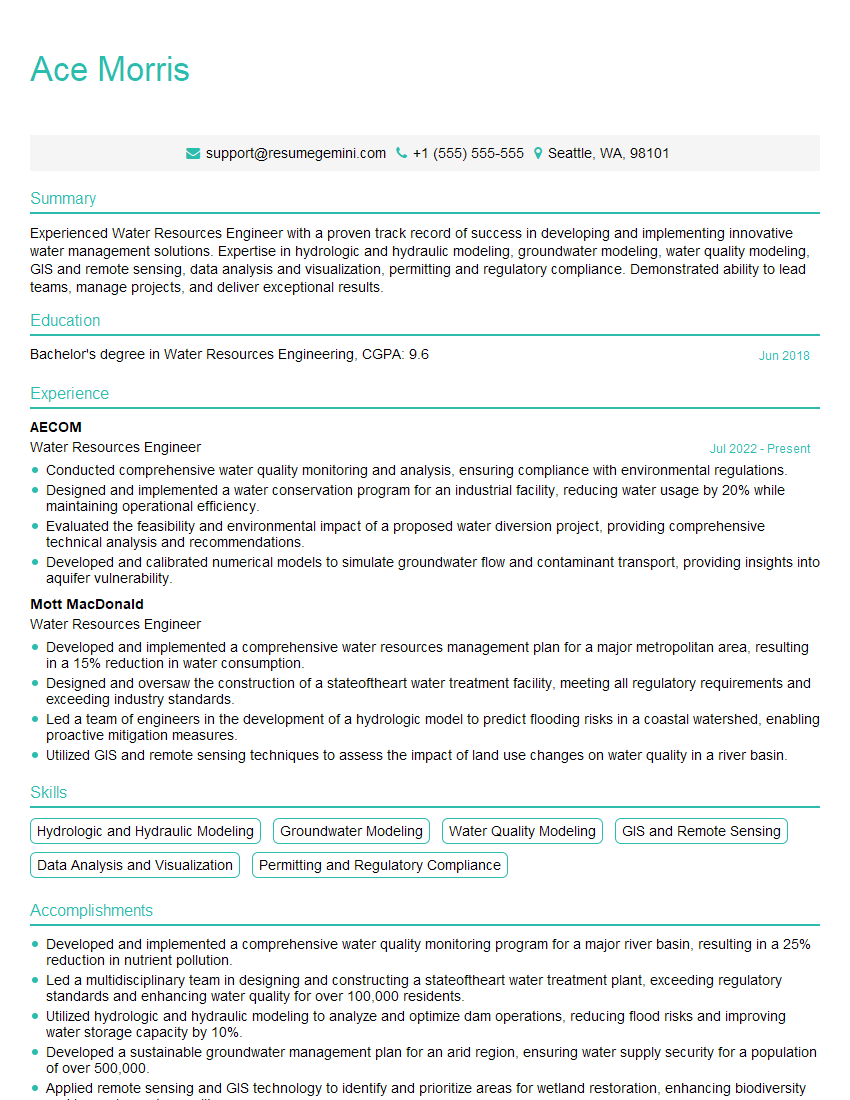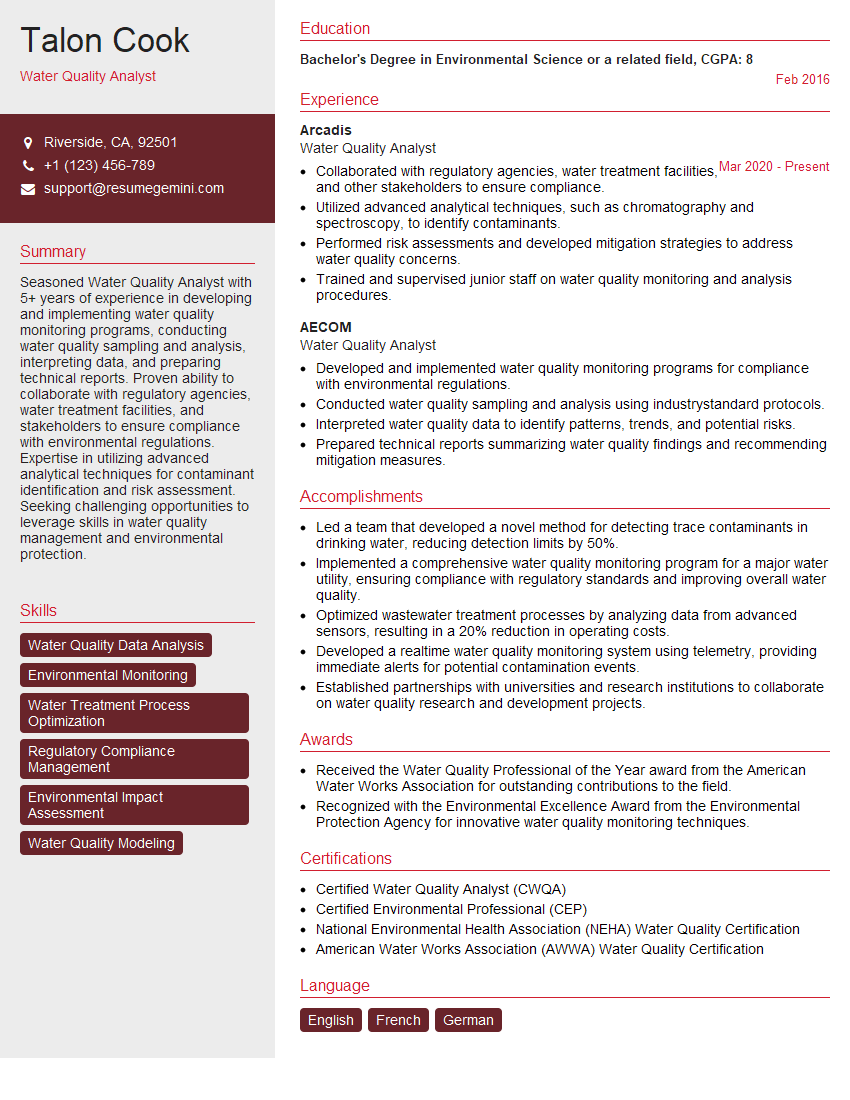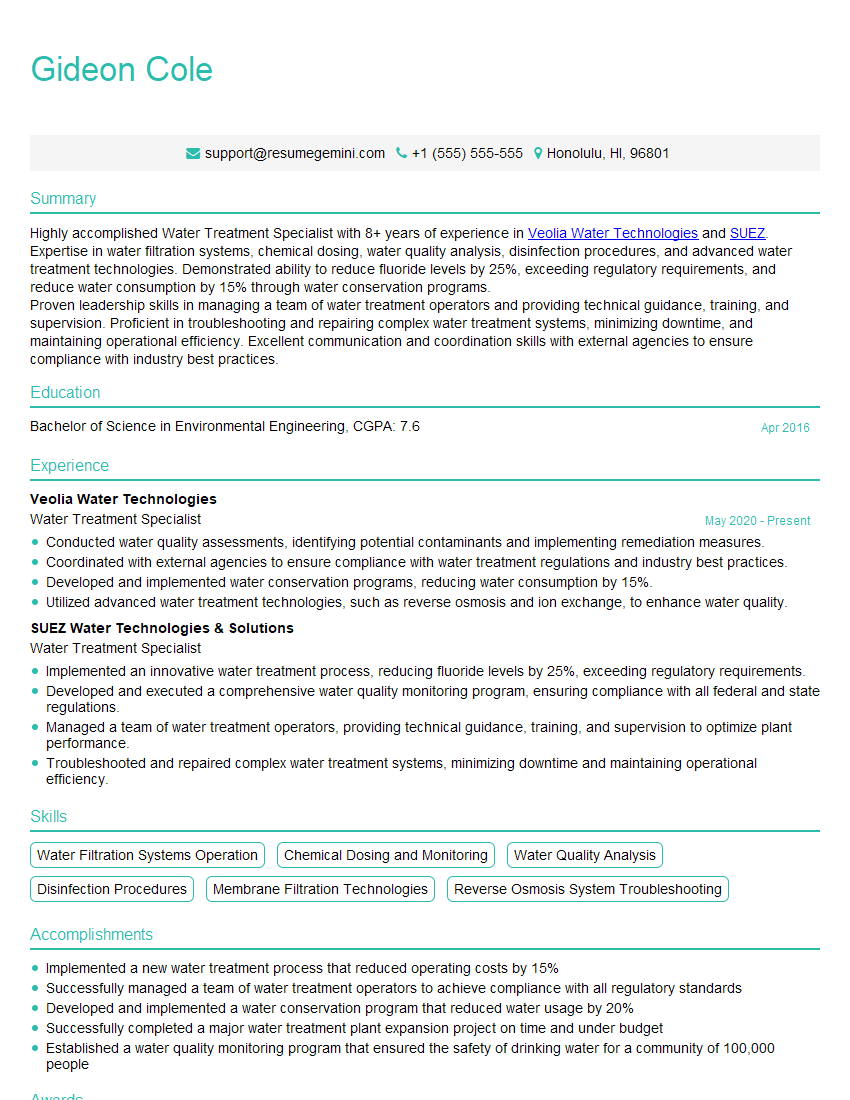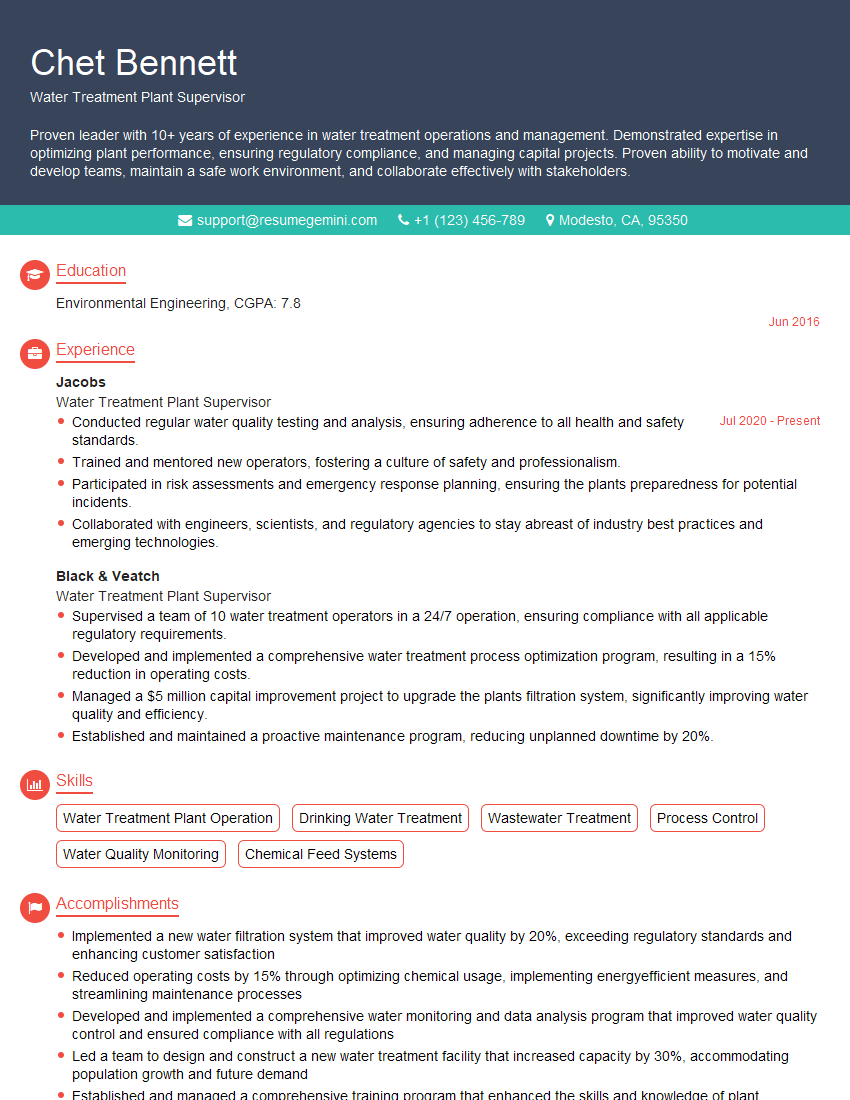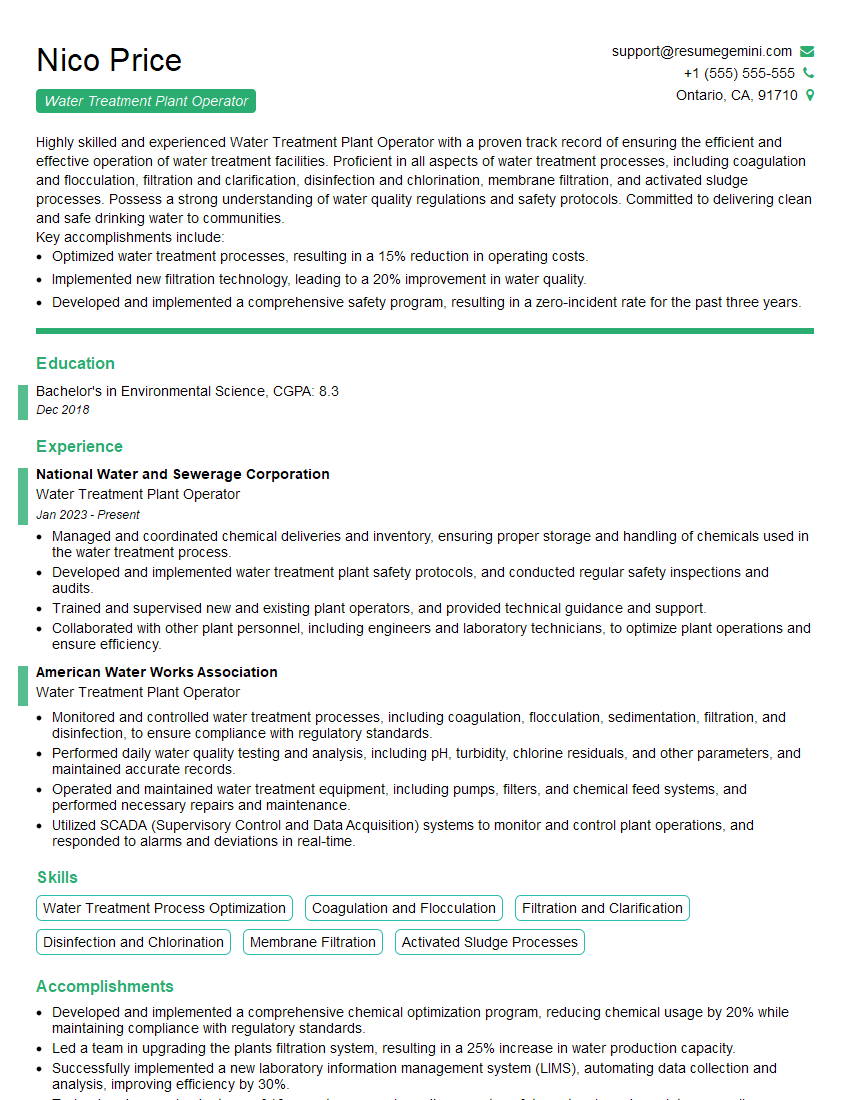Cracking a skill-specific interview, like one for Water treatment and chemistry, requires understanding the nuances of the role. In this blog, we present the questions you’re most likely to encounter, along with insights into how to answer them effectively. Let’s ensure you’re ready to make a strong impression.
Questions Asked in Water treatment and chemistry Interview
Q 1. Explain the coagulation-flocculation process in water treatment.
Coagulation-flocculation is a crucial initial step in water treatment designed to remove suspended solids and colloidal particles too small to settle out on their own. Imagine a muddy river; coagulation is like adding a special ingredient that causes the tiny mud particles to clump together, forming larger, heavier particles. This is achieved by adding coagulants, typically aluminum sulfate (alum) or ferric chloride, which neutralize the negative charges on the particles, allowing them to collide and aggregate.
Flocculation follows coagulation. Think of it as gently stirring the clumped particles to encourage them to grow even larger, forming ‘flocs.’ These flocs are large enough to settle out under gravity in a sedimentation basin. The process is often aided by gentle mixing in a flocculation tank to promote effective aggregation without breaking up the formed flocs. The settled sludge is then removed, resulting in clearer water.
For example, in a municipal water treatment plant, alum is added to raw water, followed by gentle mixing in the flocculation tank. The resulting larger flocs then settle in the sedimentation basin. The efficiency of this process is highly dependent on parameters like pH, water temperature, and coagulant dosage. Careful monitoring and adjustment are necessary for optimal performance.
Q 2. Describe different types of filtration used in water treatment.
Water treatment employs various filtration methods to remove remaining suspended solids, pathogens, and other impurities after coagulation-flocculation and sedimentation. These methods can be broadly classified as follows:
- Slow Sand Filtration: This traditional method uses a bed of sand to filter water. Biological activity within the sand bed helps remove contaminants. It’s effective but relatively slow.
- Rapid Sand Filtration: This is a faster and more common method utilizing a bed of sand and gravel. It requires pre-treatment (coagulation-flocculation) and backwashing to remove accumulated solids.
- Diatomaceous Earth (DE) Filtration: This method employs a filter medium made of diatomaceous earth, a fossilized silica-based material. It provides high-clarity filtration, often used as a polishing step.
- Membrane Filtration: This advanced method uses membranes with varying pore sizes to remove a wide range of contaminants, including bacteria and viruses. Types include microfiltration, ultrafiltration, and nanofiltration.
- Activated Carbon Filtration: This uses activated carbon, a porous material, to adsorb organic compounds, chlorine, and other taste and odor-causing substances. It is often used for polishing or taste and odor control.
The choice of filtration method depends on the water source, desired water quality, and cost considerations. For instance, membrane filtration might be employed for high-quality drinking water production, while rapid sand filtration is more suitable for larger-scale municipal applications.
Q 3. What are the key parameters used to assess water quality?
Assessing water quality requires monitoring numerous parameters, which can be broadly categorized into physical, chemical, and biological indicators.
- Physical Parameters: Turbidity (cloudiness), color, temperature, odor, and taste.
- Chemical Parameters: pH, dissolved oxygen (DO), alkalinity, hardness (calcium and magnesium ions), various metals (lead, iron, etc.), nutrients (nitrates, phosphates), and organic contaminants.
- Biological Parameters: Presence of bacteria (E. coli, coliforms), viruses, and other microorganisms. This often involves tests like the total coliform count and fecal coliform count.
The specific parameters monitored depend on the intended use of the water. For example, drinking water standards are much stricter than those for industrial use. These parameters are measured using various analytical techniques, from simple visual observations to sophisticated laboratory tests such as spectrophotometry and chromatography.
Q 4. Explain the role of disinfection in water treatment and common methods used.
Disinfection is the final critical step in water treatment, aimed at eliminating harmful pathogens like bacteria, viruses, and protozoa that can cause waterborne diseases. Think of it as the ‘safety net’ preventing illness. Several methods are commonly used:
- Chlorination: The most widely used method, adding chlorine gas or hypochlorite compounds to kill pathogens. It’s cost-effective but can produce disinfection by-products (DBPs) which are potentially harmful at high concentrations.
- Chloramination: Combining chlorine with ammonia to form chloramines. This provides longer-lasting disinfection but forms different DBPs.
- UV Disinfection: Using ultraviolet (UV) light to damage the DNA of pathogens, preventing reproduction. This is a chemical-free method but less effective against some resistant pathogens and requires clear water.
- Ozonation: Employing ozone gas, a powerful oxidizing agent, to kill pathogens. It’s effective but expensive and doesn’t provide residual disinfection.
The selection of a disinfection method depends on various factors including water quality, cost, regulatory requirements, and the presence of sensitive species. For example, UV disinfection might be preferred in situations where DBP formation is a major concern.
Q 5. What are the different types of water hardness and how are they removed?
Water hardness is primarily caused by the presence of dissolved minerals, mainly calcium and magnesium ions. There are two main types:
- Carbonate Hardness (Temporary Hardness): Caused by bicarbonates of calcium and magnesium. It can be removed by boiling the water, which converts the bicarbonates to insoluble carbonates that precipitate out. This method is effective for smaller quantities of water.
- Non-carbonate Hardness (Permanent Hardness): Caused by sulfates, chlorides, and nitrates of calcium and magnesium. Boiling doesn’t remove this type of hardness. It requires other methods like:
Removal Methods:
- Lime-Soda Softening: Adding lime (calcium hydroxide) and soda ash (sodium carbonate) to precipitate out calcium and magnesium ions as insoluble carbonates and hydroxides.
- Ion Exchange: Using ion exchange resins to replace calcium and magnesium ions with sodium ions (producing ‘soft’ water). This requires periodic regeneration of the resin.
- Reverse Osmosis (RO): A membrane filtration process that removes virtually all dissolved ions, including those causing hardness (explained in more detail below).
The choice of method depends on factors such as the level of hardness, water volume, and cost. For large-scale applications, lime-soda softening or ion exchange is commonly used.
Q 6. Describe the process of reverse osmosis (RO).
Reverse osmosis (RO) is a membrane separation process that uses pressure to force water through a semipermeable membrane, removing dissolved salts, minerals, and other impurities. Imagine trying to squeeze water through a sieve – the sieve represents the membrane, only allowing water molecules to pass while blocking larger particles and ions.
In an RO system, high pressure is applied to the water feed, forcing it against a semipermeable membrane. Water molecules pass through, while dissolved solids and other contaminants are rejected and flushed away as concentrate. The permeate, or treated water, is collected. RO systems are energy-intensive due to the high pressure requirement, but they are very effective at removing a wide range of contaminants and producing high-purity water.
RO is widely used in desalination, producing potable water from seawater, and in industrial applications needing ultrapure water, such as pharmaceutical production and semiconductor manufacturing.
Q 7. Explain the principles of ion exchange in water treatment.
Ion exchange is a water treatment process that uses resins containing charged functional groups to remove unwanted ions from water by exchanging them for other ions. Think of it like a molecular swap. The resin acts as a filter, attracting and holding specific ions while releasing others.
There are two main types of ion exchange resins:
- Cation exchange resins: These resins have negatively charged functional groups that attract and bind positively charged ions (cations) like calcium, magnesium, sodium, and potassium. They typically exchange these cations for sodium or hydrogen ions.
- Anion exchange resins: These resins possess positively charged functional groups that attract and bind negatively charged ions (anions) such as chloride, sulfate, and nitrate. They usually exchange these anions for hydroxide or chloride ions.
After a resin becomes saturated with unwanted ions, it needs regeneration. This involves passing a regenerant solution through the resin, such as a concentrated salt solution (brine) for cation exchange and an acid or base solution for anion exchange, to displace the adsorbed ions and restore the resin’s exchange capacity. Ion exchange is widely used for water softening, demineralization, and removal of specific ions, like nitrates, from water.
Q 8. What are the common chemical compounds used in water treatment and their functions?
Water treatment relies on a variety of chemical compounds to achieve different objectives, primarily disinfection, coagulation, flocculation, and pH adjustment.
- Chlorine (Cl2) and its derivatives (e.g., sodium hypochlorite): These are powerful disinfectants, killing harmful bacteria and viruses by oxidizing their cellular components. Think of it like bleach, but carefully controlled for water safety. We need to carefully monitor chlorine residuals to ensure effective disinfection without creating harmful byproducts.
- Aluminum sulfate (alum) Al2(SO4)3 and Ferric chloride (FeCl3): These are coagulants. They neutralize the charges of suspended particles in water, causing them to clump together. Imagine tiny magnets, attracting each other. This clumping makes it easier to remove these particles through sedimentation and filtration. The choice between alum and ferric chloride often depends on water characteristics and cost considerations.
- Polymers (e.g., polyacrylamide): These act as flocculants, helping the coagulated particles stick together to form larger flocs that settle out more easily. They work as a kind of glue, binding the clumps together.
- Lime (Ca(OH)2) and Soda ash (Na2CO3): These are used to adjust the pH of the water, making it less corrosive and more palatable. pH control is essential to optimize the efficiency of other treatment processes, such as coagulation and disinfection.
- Sodium bisulfite (NaHSO3): Used to dechlorinate water, especially in situations where chlorine residual needs to be removed before discharge.
The specific chemicals and their dosages depend on the source water quality and the desired treatment goals.
Q 9. How do you calculate the dosage of coagulants in water treatment?
Calculating coagulant dosage is crucial for efficient water treatment. It’s not a one-size-fits-all calculation; it requires a combination of laboratory testing and operational experience.
The process typically involves a Jar Test. This lab procedure involves adding different doses of coagulant to several samples of the water, stirring them at varying speeds, and observing the resulting floc formation and settling. The optimal coagulant dose is determined by assessing the clarity of the treated water and the speed of sedimentation.
Factors influencing dosage include:
- Turbidity: Higher turbidity (cloudiness) usually requires a higher coagulant dose.
- pH: The optimum pH for coagulation varies depending on the coagulant used.
- Water temperature: Colder water generally requires a higher dose.
- Type of coagulant: Different coagulants have different efficiencies.
Once the optimal dose is determined through jar testing, it is usually expressed in milligrams per liter (mg/L) or parts per million (ppm). This value is then used to calculate the amount of coagulant needed for the plant’s daily flow rate. This involves converting the flow rate (e.g., gallons per minute) into the volume of water treated daily, then multiplying by the optimal dose to determine the required mass of coagulant.
Q 10. What are the safety precautions you should take when handling chemicals in water treatment?
Handling chemicals in water treatment demands strict adherence to safety protocols. The consequences of improper handling can range from minor irritation to serious health problems or environmental damage.
- Personal Protective Equipment (PPE): This includes gloves, eye protection, respirators (depending on the chemical), and protective clothing to minimize skin and respiratory exposure. The type of PPE will vary depending on the specific chemical being handled.
- Proper Storage: Chemicals should be stored in designated areas, away from incompatible substances. Storage containers must be clearly labeled with the chemical name, hazards, and safety instructions. Storage areas should be well-ventilated and protected from extreme temperatures.
- Spill Response Procedures: Spills must be handled immediately and safely using appropriate absorbent materials and neutralizing agents, if necessary. Emergency response plans should be in place and regularly practiced.
- Employee Training: All personnel handling chemicals must receive comprehensive training on the safe handling, storage, and emergency response procedures for each chemical used in the plant. This training should be regularly updated and reinforced.
- Material Safety Data Sheets (MSDS): MSDSs provide critical information about the hazards of each chemical and the necessary safety precautions. These sheets should be readily available and consulted before handling any chemical.
Remember, safety is not just a policy; it’s a mindset. A culture of safety within a water treatment plant is paramount to protecting workers and the environment.
Q 11. Describe different types of water treatment membranes and their applications.
Membrane filtration plays a vital role in advanced water treatment, offering various options for removing contaminants based on size and charge.
- Microfiltration (MF): Removes particles larger than 0.1-10 micrometers, including suspended solids, bacteria, and some protozoa. It’s like a very fine sieve. Applications include pretreatment for other membrane processes, and removal of suspended solids.
- Ultrafiltration (UF): Removes particles larger than 0.01-0.1 micrometers, including viruses and larger organic molecules. Applications include removal of dissolved organic matter (DOM) and virus removal from drinking water.
- Nanofiltration (NF): Removes dissolved salts, multivalent ions, and organic molecules with molecular weights exceeding 200-1000 Da. It’s more selective than UF. Applications include softening, desalination and removal of color and other dissolved organics.
- Reverse Osmosis (RO): Removes dissolved salts, minerals, and a wide range of organic and inorganic molecules. It’s the most selective membrane process. Applications include desalination, producing high-purity water for industrial processes, and advanced wastewater treatment.
The choice of membrane depends on the specific contaminants to be removed and the desired level of treatment. Each membrane type has its own strengths and limitations, including fouling potential (membrane clogging) and energy requirements. Regular cleaning and maintenance are essential for optimal membrane performance and longevity.
Q 12. Explain the concept of water balance in a water treatment plant.
Water balance in a water treatment plant refers to the careful management of water inflow and outflow to ensure efficient operation and prevent problems such as overflows, underflows, and water losses. It’s like balancing a budget, but with water instead of money.
A well-managed water balance considers:
- Influent flow rate: The rate at which raw water enters the plant.
- Treatment process demands: The water required for each treatment stage (e.g., coagulation, filtration, disinfection).
- Effluent flow rate: The rate at which treated water leaves the plant.
- Wastewater generation: The volume of water lost or removed during the treatment process (backwashing, sludge disposal).
- Storage capacity: The amount of water that can be stored within the plant for peak demand or emergency situations.
Maintaining a proper water balance requires continuous monitoring of flow rates, water levels, and pressure. Adjustments to valves, pumps, and treatment processes are made as needed to ensure that the plant operates smoothly and efficiently. Any imbalance can significantly affect the effectiveness of the treatment process and can lead to operational inefficiencies and potential environmental risks. Accurate flow measurement and careful process control are fundamental to effective water balance management.
Q 13. What are the common problems encountered in water treatment plants and how do you address them?
Water treatment plants frequently encounter various operational challenges.
- Membrane Fouling: Membrane processes can be susceptible to fouling, where accumulated material reduces membrane permeability. Regular cleaning and chemical treatments help mitigate this. In extreme cases, membrane replacement may be necessary.
- High Turbidity: Unexpectedly high turbidity in the raw water can overwhelm the treatment process, resulting in poor water quality. Adjusting coagulant dosages and possibly employing pretreatment measures is crucial.
- Biological Growth: Bacteria and other microorganisms can proliferate within the plant, impacting water quality and clogging filters. Regular disinfection, cleaning, and maintenance are essential to control biological growth.
- Chemical Scaling: The precipitation of minerals from the water (scaling) can occur in pipes and equipment. This is often addressed through pH adjustment and the use of antiscalants.
- Equipment Malfunction: Pump failures, filter clogging, or other equipment issues can disrupt the treatment process. Preventive maintenance and timely repairs are key. Redundancy in critical equipment helps to minimize downtime.
Addressing these problems requires a combination of preventative measures, diligent monitoring, and timely corrective actions. A robust preventative maintenance program can greatly reduce downtime and operational issues.
Q 14. How do you monitor and control the efficiency of a water treatment process?
Monitoring and controlling the efficiency of a water treatment process is crucial for ensuring consistent water quality and plant optimization.
This involves continuous monitoring of various parameters:
- Physical parameters: Turbidity, pH, temperature, flow rate, pressure.
- Chemical parameters: Chlorine residual, coagulant levels, dissolved oxygen, various ions (e.g., calcium, magnesium, nitrates).
- Biological parameters: Bacterial counts, presence of indicator organisms (e.g., E. coli).
These parameters are monitored using online sensors, laboratory analysis, and regular inspections. Data is then used to adjust treatment processes as needed, for example: adjusting coagulant dose based on turbidity measurements or altering chlorine feed rate to maintain a desired residual. Data analysis can reveal trends and help identify potential issues before they become major problems.
Process efficiency is further evaluated by:
- Treatment efficiency: Percentage removal of specific contaminants.
- Energy consumption: Monitoring energy use per unit of water treated.
- Chemical usage: Tracking the amount of chemicals used and optimizing their use to minimize costs and environmental impacts.
Regular performance evaluations and audits allow for identification of areas for improvement and optimization of the treatment process.
Q 15. What are the regulatory requirements for water quality in your area?
Water quality regulations vary significantly depending on location. In my area (please replace with your specific area and regulations), the primary regulatory body is [Name of Regulatory Body]. They enforce standards outlined in [Name of Relevant Legislation or Standard, e.g., Safe Drinking Water Act]. Key parameters include:
- Maximum Contaminant Levels (MCLs): These legally enforceable limits specify the maximum permissible concentration of various contaminants, such as bacteria, nitrates, lead, arsenic, and pesticides. Exceeding these levels can result in significant penalties.
- Treatment Technique Requirements (TTRs): For certain contaminants where achieving an MCL is difficult, TTRs mandate the use of specific treatment technologies to reduce the contaminant to a certain level.
- Monitoring and Reporting: Regular monitoring and reporting of water quality parameters are mandatory to ensure compliance. This often involves submitting detailed reports to the regulatory agency.
Failure to comply with these regulations can lead to significant fines, operational shutdowns, and reputational damage. Therefore, thorough understanding and adherence to local regulations is crucial for any water treatment facility.
Career Expert Tips:
- Ace those interviews! Prepare effectively by reviewing the Top 50 Most Common Interview Questions on ResumeGemini.
- Navigate your job search with confidence! Explore a wide range of Career Tips on ResumeGemini. Learn about common challenges and recommendations to overcome them.
- Craft the perfect resume! Master the Art of Resume Writing with ResumeGemini’s guide. Showcase your unique qualifications and achievements effectively.
- Don’t miss out on holiday savings! Build your dream resume with ResumeGemini’s ATS optimized templates.
Q 16. Explain the difference between potable water and wastewater.
The distinction between potable water and wastewater is fundamental in water treatment. Potable water is water that is safe for human consumption. It’s free from harmful bacteria, viruses, parasites, and chemicals at levels that pose a health risk. This requires extensive treatment processes to ensure its purity. Conversely, wastewater is water that has been used and contains contaminants from various sources, including human waste, industrial discharge, and storm runoff. It’s not safe for consumption and often requires treatment to remove pollutants before it can be safely returned to the environment.
Think of it like this: potable water is the ‘clean’ water we drink from the tap, while wastewater is the ‘dirty’ water that needs to be cleaned before being released back into nature. The treatment processes for each are vastly different, with potable water treatment focused on disinfection and contaminant removal, while wastewater treatment aims to remove organic matter, nutrients, and pathogens.
Q 17. What are the various methods for removing iron and manganese from water?
Iron and manganese are common groundwater contaminants that cause aesthetic problems like discoloration and staining, and can also impact taste and odor. Several methods exist for their removal:
- Oxidation: This is a primary step involving exposing the water to oxygen to convert soluble ferrous iron (Fe2+) and manganous manganese (Mn2+) into insoluble ferric iron (Fe3+) and manganic manganese (Mn4+). This can be achieved through aeration, chlorination, potassium permanganate, or ozone treatment.
- Filtration: After oxidation, the insoluble iron and manganese precipitate out of the solution. These precipitates are then removed through various filtration processes, such as sand filtration, multimedia filtration, or membrane filtration (microfiltration, ultrafiltration).
- Ion Exchange: This method uses a resin that exchanges dissolved iron and manganese ions for other ions, typically sodium or chloride. It’s highly effective but requires periodic regeneration of the resin.
- Reverse Osmosis (RO): This membrane process removes dissolved ions, including iron and manganese, effectively purifying the water. It’s a more expensive option but yields high-quality water.
The choice of method depends on factors such as the concentration of iron and manganese, water quality characteristics, and cost considerations. A combination of methods is often employed for optimal results.
Q 18. Describe the process of sludge management in wastewater treatment.
Sludge management is a crucial aspect of wastewater treatment. Sludge is the semisolid byproduct of wastewater treatment processes, containing organic matter, pathogens, and other contaminants. Effective sludge management ensures safe disposal or beneficial reuse, minimizing environmental impact.
- Thickening: Reduces sludge volume by concentrating solids through gravity thickening or other mechanical processes.
- Stabilization: Reduces the risk of pathogens and unpleasant odors through anaerobic digestion (producing biogas), aerobic digestion, or chemical stabilization.
- Dewatering: Further reduces sludge volume by removing water, often using belt presses, centrifuges, or vacuum filters. This produces a cake that is easier to handle and transport.
- Disposal or Reuse: Dewatered sludge can be disposed of in landfills, incinerated, or land-applied as a fertilizer (after careful analysis and regulatory compliance). Reuse options include land reclamation and soil amendment.
Careful sludge management is essential to prevent environmental pollution and comply with regulations. The choice of methods depends on factors like sludge characteristics, local regulations, and cost-effectiveness.
Q 19. Explain the principles of activated sludge process.
The activated sludge process is a widely used secondary wastewater treatment method that utilizes microorganisms to biologically remove organic matter. It’s a continuous process involving:
- Aeration Tank: Wastewater is mixed with activated sludge (a mixture of microorganisms) and aerated to provide oxygen for the microorganisms to break down organic matter. The microorganisms consume the organic matter, converting it into carbon dioxide, water, and new microbial cells.
- Clarifier (Secondary Settling Tank): After the aeration tank, the mixture flows into a clarifier where the activated sludge settles to the bottom, forming a concentrated sludge layer. The clarified effluent is then discharged.
- Return Activated Sludge (RAS): A portion of the settled sludge is recycled back to the aeration tank to maintain a sufficient population of microorganisms. This ensures continuous breakdown of organic matter.
- Waste Activated Sludge (WAS): Excess sludge is withdrawn from the system for further processing (thickening, stabilization, dewatering).
The activated sludge process efficiently removes organic matter and improves the quality of wastewater before it is discharged. Careful control of parameters like aeration, sludge age, and food-to-microorganism ratio is crucial for optimal performance.
Q 20. What is the significance of pH in water treatment?
pH plays a crucial role in water treatment for several reasons:
- Disinfection Efficiency: The effectiveness of disinfectants like chlorine is highly dependent on pH. Optimal pH ranges exist for maximizing disinfection while minimizing the formation of unwanted disinfection byproducts.
- Chemical Reactions: Many chemical processes used in water treatment, such as coagulation, flocculation, and softening, are pH-dependent. Specific pH ranges are required for the optimal performance of these processes.
- Corrosion Control: pH influences the corrosiveness of water. Maintaining a slightly alkaline pH reduces corrosion in water distribution systems.
- Toxicity: The toxicity of some contaminants can vary with pH. For example, the toxicity of some metals increases at lower pH levels.
- Precipitation/Dissolution: The solubility of many compounds in water is influenced by pH, determining whether they will precipitate out of the water or remain dissolved.
Therefore, pH control and monitoring are essential throughout the water treatment process to ensure efficient treatment, minimize adverse impacts on infrastructure, and produce high-quality water.
Q 21. How do you perform a jar test and what information does it provide?
The jar test is a simple but effective laboratory procedure used to evaluate the effectiveness of different coagulants and flocculants in water treatment. It helps determine the optimal coagulant dose and coagulation conditions.
Procedure:
- Several jars containing a representative sample of the water are prepared.
- Different doses of the coagulant are added to each jar.
- The jars are stirred rapidly for a specific time to promote rapid mixing.
- Stirring speed is then reduced to promote flocculation (formation of larger flocs).
- The jars are allowed to settle, and the clarity of the supernatant (the clear liquid above the settled solids) is visually assessed.
Information Provided:
- Optimal Coagulant Dose: The jar test helps determine the coagulant dose that produces the clearest supernatant, indicating effective removal of suspended solids.
- Flocculation Characteristics: The size and structure of the flocs formed indicate the effectiveness of the coagulant and the overall process.
- Coagulation Performance: The clarity of the supernatant provides a measure of the overall coagulation performance.
The jar test is a rapid, low-cost method used to optimize coagulation processes and ensure effective water treatment. It’s typically performed before implementing changes at a larger scale to minimize cost and avoid potential problems.
Q 22. Explain the concept of water softening.
Water softening is the process of reducing the concentration of dissolved minerals, primarily calcium and magnesium ions, in water. These minerals cause water hardness, leading to scale buildup in pipes, appliances, and reduced efficiency of soaps and detergents. The process aims to improve water quality for domestic and industrial purposes.
Common methods include:
- Ion exchange: This involves passing hard water through a resin bed containing sodium ions. The resin exchanges sodium ions for calcium and magnesium ions, effectively softening the water. The resin bed needs periodic regeneration using a concentrated brine solution to remove the accumulated calcium and magnesium.
- Lime softening: This chemical process uses lime (calcium hydroxide) to precipitate calcium and magnesium ions out of solution as insoluble carbonates. This requires careful pH control and produces a sludge which needs to be disposed of.
- Reverse osmosis: This membrane filtration process removes dissolved minerals, including calcium and magnesium, along with other impurities. It produces high-quality, soft water but is energy-intensive.
Imagine trying to wash clothes with hard water – the soap won’t lather properly, and you’ll end up with a film on your clothes. Water softening solves this problem by making the water less ‘hard’ and more effective for cleaning.
Q 23. What are the different types of corrosion and how do they affect water treatment systems?
Corrosion in water treatment systems is the deterioration of materials due to chemical or electrochemical reactions with the water. Several types exist:
- Uniform corrosion: This involves a relatively even degradation of the metal surface across a wide area. It’s predictable but can still cause significant damage over time.
- Pitting corrosion: This localized attack forms small, deep pits on the metal surface, leading to structural weakening and potential leaks. It’s difficult to detect early and can cause catastrophic failures.
- Galvanic corrosion: This occurs when two dissimilar metals are in contact in the presence of an electrolyte (water). The more active metal corrodes preferentially. For example, a steel pipe connected to a copper fitting in a water system could suffer from galvanic corrosion.
- Crevice corrosion: This occurs in confined spaces or crevices where water stagnation and oxygen depletion create highly corrosive environments. Gaskets, welds, and valve seats are particularly vulnerable.
Corrosion affects water treatment systems by reducing their lifespan, causing leaks, contaminating the water with metal ions, and increasing maintenance costs. Proper material selection, water chemistry control (pH, dissolved oxygen), and cathodic protection are crucial in mitigating corrosion.
Q 24. Describe the use of UV disinfection in water treatment.
UV disinfection utilizes ultraviolet light to inactivate microorganisms in water by damaging their DNA. UV lamps emit short-wavelength UV-C light (around 254 nm), which is highly effective at destroying bacteria, viruses, and protozoa. The water flows through a chamber where it’s exposed to UV-C light for a specific contact time to ensure sufficient inactivation.
The process is environmentally friendly, doesn’t add chemicals to the water, and is relatively easy to operate. However, UV disinfection alone is not always sufficient to inactivate all pathogens, particularly resistant ones, and requires careful monitoring of lamp intensity and water turbidity.
Imagine UV light as a tiny, powerful weapon that destroys the genetic material of harmful microorganisms, preventing them from reproducing and causing disease.
Q 25. What are the advantages and disadvantages of using chlorine as a disinfectant?
Chlorine is a widely used disinfectant in water treatment due to its effectiveness, affordability, and relatively long-lasting residual effect. It kills a broad range of pathogens but also has drawbacks.
Advantages:
- High effectiveness against bacteria and viruses.
- Relatively low cost.
- Provides a residual disinfectant, protecting the water during distribution.
Disadvantages:
- Formation of disinfection byproducts (DBPs), such as trihalomethanes (THMs), which are potential carcinogens. The concentration of chlorine needs to be carefully controlled.
- Potential for taste and odor problems in treated water.
- Ineffective against some resistant microorganisms like Cryptosporidium.
- Can react with organic matter in water, reducing its effectiveness.
The decision to use chlorine involves balancing its effectiveness against the potential risks associated with DBP formation. Advanced treatment technologies are often used in conjunction with chlorine to mitigate these risks.
Q 26. How do you troubleshoot a malfunctioning water treatment system?
Troubleshooting a malfunctioning water treatment system requires a systematic approach:
- Identify the problem: Determine the specific malfunction – is there low water pressure, poor disinfection, or a change in water quality?
- Gather data: Collect information such as flow rates, pressure readings, chemical concentrations (e.g., chlorine residual), turbidity, and any error messages from the system’s control panel.
- Check the basics: Ensure proper power supply, adequate chemical feed, and that all pumps and valves are operating correctly.
- Analyze data: Look for patterns or trends in the collected data that might pinpoint the cause of the problem. For example, low chlorine residual might indicate a problem with the chlorination system.
- Isolate the problem: Systematically test components to identify the faulty part. This might involve checking individual sensors, pumps, or treatment units.
- Repair or replace: Once the problem is identified, repair or replace the faulty component.
- Verify the repair: Monitor the system after the repair to ensure that it is functioning correctly.
Documenting the troubleshooting process is essential for future reference and for improving the system’s maintenance.
Q 27. Explain the concept of water sustainability.
Water sustainability refers to the responsible management of water resources to meet the needs of present and future generations. It encompasses the social, economic, and environmental aspects of water use. It means ensuring enough clean water is available for drinking, sanitation, agriculture, industry, and ecosystems.
Key aspects of water sustainability include:
- Efficient water use: Reducing water consumption through improved irrigation techniques, water-efficient appliances, and industrial processes.
- Water conservation: Protecting water sources from pollution and degradation through careful land management practices.
- Water reuse and recycling: Treating and reusing wastewater for various purposes, such as irrigation or industrial cooling.
- Water infrastructure development: Investing in infrastructure to improve water storage, distribution, and treatment.
- Integrated water resource management: Considering all aspects of water management in a holistic manner.
Water sustainability isn’t just about conserving water; it’s about ensuring equitable access to clean water for everyone and protecting the environment for the long term.
Q 28. Describe your experience with water treatment plant automation and SCADA systems.
I have extensive experience with water treatment plant automation and SCADA (Supervisory Control and Data Acquisition) systems. I’ve been involved in the design, implementation, and maintenance of SCADA systems for various water treatment plants, ranging from small municipal plants to large industrial facilities.
My experience includes:
- Programming PLCs (Programmable Logic Controllers) to control various plant processes, such as chemical dosing, filtration, and disinfection.
- Developing and configuring SCADA software to monitor and control plant operations in real-time, providing operators with a centralized view of the entire system.
- Implementing data logging and reporting systems for tracking key performance indicators (KPIs) and identifying areas for improvement.
- Troubleshooting and resolving SCADA system issues, ensuring efficient and reliable plant operation.
- Integrating various sensors, actuators, and other field devices into the SCADA system.
I’m proficient in various SCADA platforms and programming languages and have a strong understanding of industrial communication protocols like Modbus and Profibus. My experience also encompasses integrating advanced analytics and machine learning techniques into SCADA systems for predictive maintenance and process optimization.
For example, in one project, I implemented a SCADA system that significantly improved the efficiency of a water treatment plant by optimizing chemical dosing based on real-time water quality data, resulting in cost savings and improved water quality.
Key Topics to Learn for Water Treatment and Chemistry Interviews
- Water Chemistry Fundamentals: Understanding pH, alkalinity, hardness, dissolved oxygen, and their impact on water quality. Practical application: Troubleshooting water quality issues in a treatment plant.
- Treatment Processes: Coagulation/flocculation, sedimentation, filtration (various types), disinfection (chlorination, UV, ozonation). Practical application: Designing and optimizing a water treatment process for a specific water source.
- Membrane Technologies: Reverse osmosis (RO), microfiltration (MF), ultrafiltration (UF). Practical application: Selecting the appropriate membrane technology for a given application, understanding membrane fouling and cleaning.
- Water Quality Monitoring and Analysis: Understanding various analytical techniques (e.g., titrations, spectrophotometry) and interpreting results. Practical application: Assessing the effectiveness of a treatment process and ensuring compliance with regulations.
- Water Microbiology: Understanding the role of microorganisms in water treatment and the methods used to control them. Practical application: Preventing and managing microbial contamination in drinking water systems.
- Regulations and Compliance: Familiarity with relevant water quality regulations and standards (e.g., Safe Drinking Water Act). Practical application: Ensuring a treatment plant operates within regulatory compliance.
- Instrumentation and Process Control: Understanding the function and operation of common water treatment equipment and instrumentation. Practical application: Troubleshooting malfunctions and optimizing treatment processes using control systems.
- Chemical Handling and Safety: Safe handling and storage of chemicals commonly used in water treatment. Practical application: Implementing safety protocols to minimize risks associated with chemical use.
Next Steps
Mastering water treatment and chemistry opens doors to exciting and impactful careers, offering opportunities for innovation and contribution to public health and environmental sustainability. A strong resume is crucial for showcasing your skills and experience to potential employers. Creating an ATS-friendly resume significantly increases your chances of getting noticed by recruiters. We highly recommend using ResumeGemini to build a professional and effective resume that highlights your expertise in water treatment and chemistry. ResumeGemini provides examples of resumes tailored to this specific field, helping you craft a compelling application that stands out from the competition.
Explore more articles
Users Rating of Our Blogs
Share Your Experience
We value your feedback! Please rate our content and share your thoughts (optional).
What Readers Say About Our Blog
Hi, I’m Jay, we have a few potential clients that are interested in your services, thought you might be a good fit. I’d love to talk about the details, when do you have time to talk?
Best,
Jay
Founder | CEO
